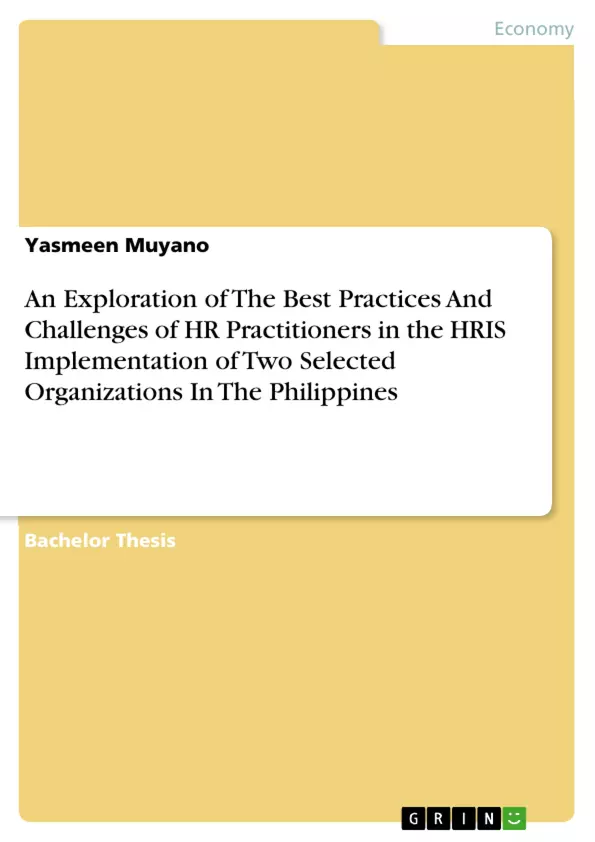This study explored the challenges and benefits of an HRIS software when used in the general aspects of the Human Resources Department of two organizations. Human Resource Management has been a big factor in the determination of the course of companies in the Philippines. It involves the employment of the right people to do the right job to properly initiate the start of the success of an organization, following through to the maintenance of the status of employees as well as the continuous surveillance of their work.
As time goes by, the work of the Human Resource Department grows more complex and is continuously gaining tremendous workload. Thus, the difficulty of maintaining an organized load of work in the HR Department and the complication of finishing their work arises. The basic concept of this study is for the other companies to develop the perspective that the implementation of such system would fully help them in the complex work of the HR Department. To achieve this objective, data was taken from employees of the two organizations of different fields if the Automation of the Human Resource System of their company helped them in their heavy workload.
The study explored, compared, and evaluated the experiences of employees from two companies in the implementation of HRIS using qualitative approach, comparative research design, and in-depth interviewing method.
Table of Contents
- Title Page
- Abstract
- Approval Sheet
- Table of Contents
- Certificate of Originality
- Acknowledgement
- Chapter One - Introduction
- Statement of the Problem
- Background of the Study
- Significance of the Study
- Objectives of the Study
- Theoretical Framework
- Conceptual Framework
- Scope and Limitation of the Study
- Definition of Terms
- Chapter Two - Review of Related Literature
- Related Studies
- Chapter Three – Research Methodology
- Research Design
- Data Collection Methods and Tools
- Data Gathering Procedure
- Research Process
- Chapter Four - Results
- Chapter Five - Summary, Conclusions and Recommendations
- Discussion
- Summary
- Conclusions
- Recommendations for Future Research
- References
- Appendices
Objectives and Key Themes
This thesis investigates the challenges and advantages of implementing HRIS software within the Human Resources departments of two organizations in the Philippines. The study aims to analyze how this software influences the efficiency and effectiveness of HR operations, particularly in relation to the growing workload and complexities of HR management in the modern era. The research seeks to provide insights for other organizations considering the adoption of HRIS systems.
- Impact of HRIS on Human Resource Management
- Challenges and Benefits of HRIS Implementation
- Qualitative Analysis of Employee Experiences with HRIS
- Comparison of HRIS Implementation in Different Organizational Contexts
- Automation of HR Processes and its Effects on Efficiency
Chapter Summaries
Chapter 1 introduces the study, outlining the problem of increasing workload and complexity within HR departments, the significance of HRIS implementation, and the study's objectives. It also delves into the theoretical and conceptual framework of the research. Chapter 2 examines existing literature and related studies focusing on HRIS implementation and its impact on HR management. Chapter 3 details the research methodology, including the research design, data collection methods, data gathering procedures, and the research process. Chapter 4 presents the findings of the study based on data collected from employees of the two selected organizations. Chapter 5 concludes the study by summarizing the findings, drawing conclusions about the challenges and benefits of HRIS implementation, and providing recommendations for future research.
Keywords
This study focuses on the keywords Human Resource Management, Automation, Recruitment, Organizing, Difficulty, and HR Department. The research analyzes the role of HRIS implementation in addressing the challenges of HR management, particularly the increasing complexity and workload associated with modern HR practices. The study explores the impact of automation on various aspects of HR operations, including recruitment, organization, and overall efficiency.
- Citar trabajo
- Yasmeen Muyano (Autor), 2019, An Exploration of The Best Practices And Challenges of HR Practitioners in the HRIS Implementation of Two Selected Organizations In The Philippines, Múnich, GRIN Verlag, https://www.grin.com/document/477612



